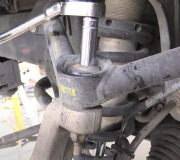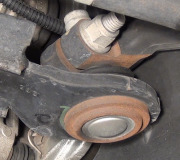There's two more variables to keep in mind. The first is the blocks of tread allow the rubber to squirm a little. That can help absorb road shock. After two years, those blocks of rubber are worn down and are less able to flex. That could be why the wobble is caused by the tires now, but not previously.
The other variable most people aren't aware of is sagged springs. That changes the geometric relationship of the steering and suspension parts, and how they react to road forces. Every tire and alignment shop has a small book that shows the places to measure and what the measurements should be for every year and model. I can only find the rear specs for your vehicle to show you what we look for. The first picture shows the specs for the rear suspension and what they should be. Most manufacturers have you measure between a point on the vehicle, to the ground. Chrysler has always used methods that at first seem rather complicated, but they take into account different tire sizes. Here they show measuring from the axle tube to the frame. It doesn't matter what the tire size is. Conscientious alignment technicians will measure ride height before agreeing to align the vehicle. Sagged ride height is much less of a problem with this suspension design, but it can be a huge cause of poor tire wear on other models even when the alignment numbers look perfect.
A similar front suspension system is used on full-size Dodge trucks and on your Jeep. In the second drawing, the left side is shown. Of particular interest are the upper and lower control arms, (blue and purple arrows). On the trucks, if you site straight up or down over them, you'd see they are very nearly parallel to each other. There is nothing to keep them from letting the front axle housing shift to either side. (The lower arm is connected to the axle through bushing number 5. The upper arm is connected the same way, but its bushing isn't shown).
If that's all you had was those four control arms, two on each side, it would be almost impossible to slowly drive the vehicle into the shop without hitting something. Every tiny bump or vibration would make the axle shift, along with the steering system's relationship between the axle / wheels and the steering gear box / frame. It's the track bar, item # 9, (2 red arrows), that holds the axle from shifting sideways. This track bar caused a huge problem the first few years it was used. Minor play in the ball and socket, (2 red arrows), allowed the axle to shift just enough to cause miserable steering wander. It made for a very tiring truck to drive.
To make a side-note for a moment, there was a service bulletin for that steering wander, and the track bar was only one of two possible causes. I remember the approximate allowable movement between the two red arrows, but it is irrelevant. If you ever find one with that much movement, it has been causing misery for years. Instead, I identified these by having a helper slowly turn the steering wheel left and right a few inches with the engine running. If you can see perceptible movement up and down between the ball and socket, that is too much play and the bar must be replaced. The service bulletin allows.084" movement which has to be measured with a dial indicator. With even.050" of play, you won't want to drive the truck very far.
That play can be a contributing factor to the death wobble, but that never seemed to be a problem on the trucks. It affects the Jeep models more, but what's strange is if you sight down those two control arms, you'll see they aren't parallel like they are on the trucks. They form somewhat of an "X". That greatly reduces the importance of the track bar, but that makes it easy to overlook. You might want to look closer at it to see if it is worn. With your helper oscillating the steering wheel back and forth, the steering linkage puts pressure on the axle housing due to the tires' reluctance to slide across the road surface. That sideways pressure and movement is supposed to be controlled by the track bar. Because of the pressure placed on it, you would expect to see the end moving sideways related to the ball and stud, but in fact, the socket moves up and down. If that movement is excessive, due to the "X" formed by the control arms, you might not get the steering wander, but it would sure play a role in the death wobble.
If I didn't do a good job of describing where to see that objectionable movement, it could be imagined as the two red arrows are getting closer together, then farther apart as the steering wheel is flipped back and forth a few inches. We were supposed to use a dial indicator to see that, but if it was enough to cause a problem, you could see it by eye if you watched close enough.
Images (Click to make bigger)
Thursday, December 10th, 2020 AT 10:11 PM







